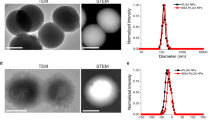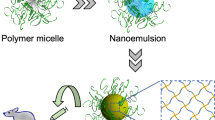Abstract
New strategies to self-assemble biocompatible materials into nanoscale, drug-loaded packages with improved therapeutic efficacy are needed for nanomedicine. To address this need, we developed artificial recombinant chimeric polypeptides (CPs) that spontaneously self-assemble into sub-100-nm-sized, near-monodisperse nanoparticles on conjugation of diverse hydrophobic molecules, including chemotherapeutics. These CPs consist of a biodegradable polypeptide that is attached to a short Cys-rich segment. Covalent modification of the Cys residues with a structurally diverse set of hydrophobic small molecules, including chemotherapeutics, leads to spontaneous formation of nanoparticles over a range of CP compositions and molecular weights. When used to deliver chemotherapeutics to a murine cancer model, CP nanoparticles have a fourfold higher maximum tolerated dose than free drug, and induce nearly complete tumour regression after a single dose. This simple strategy can promote co-assembly of drugs, imaging agents and targeting moieties into multifunctional nanomedicines.
This is a preview of subscription content, access via your institution
Access options
Subscribe to this journal
Receive 12 print issues and online access
$259.00 per year
only $21.58 per issue
Buy this article
- Purchase on Springer Link
- Instant access to full article PDF
Prices may be subject to local taxes which are calculated during checkout






Similar content being viewed by others
References
Drummond, D. C., Meyer, O., Hong, K., Kirpotin, D. B. & Papahadjopoulos, D. Optimizing liposomes for delivery of chemotherapeutic agents to solid tumors. Pharmacol. Rev. 51, 691–743 (1999).
Duncan, R. Polymer conjugates as anticancer nanomedicines. Nature Rev. Cancer 6, 688–701 (2006).
Lee, C. C., MacKay, J. A., Frechet, J. M. & Szoka, F. C. Designing dendrimers for biological applications. Nature Biotechnol. 23, 1517–1526 (2005).
Matsumura, Y. & Maeda, H. A new concept for macromolecular therapeutics in cancer chemotherapy: Mechanism of tumoritropic accumulation of proteins and the antitumor agent smancs. Cancer Res. 46, 6387–6392 (1986).
Brannon-Peppas, L. & Blanchette, J. O. Nanoparticle and targeted systems for cancer therapy. Adv. Drug Deliv. Rev. 56, 1649–1659 (2004).
Urry, D. W. Physical chemistry of biological free energy transduction as demonstrated by elastic protein-based polymers. J. Phys. Chem. B 101, 11007–11028 (1997).
Yamaoka, T. et al. Mechanism for the phase transition of a genetically engineered elastin model peptide (VPGIG)(40) in aqueous solution. Biomacromolecules 4, 1680–1685 (2003).
Cappello, J. et al. In situ self-assembling protein polymer gel systems for administration, delivery, and release of drugs. J. Control. Release 53, 105–117 (1998).
Dreher, M. R. et al. Temperature triggered self-assembly of polypeptides into multivalent spherical micelles. J. Am. Chem. Soc. 130, 687–694 (2008).
Wright, E. R. & Conticello, V. P. Self-assembly of block copolymers derived from elastin-mimetic polypeptide sequences. Adv. Drug Deliv. Rev. 54, 1057–1073 (2002).
Megeed, Z., Cappello, J. & Ghandehari, H. Genetically engineered silk-elastinlike protein polymers for controlled drug delivery. Adv. Drug Deliv. Rev. 54, 1075–1091 (2002).
Urry, D. W., Parker, T. M., Reid, M. C. & Gowda, D. C. Biocompatibility of the bioelastic materials, poly(Gvgvp) and its gamma-irradiation cross-linked matrix—summary of generic biological test-results. J. Bioact. Compat. Polym. 6, 263–282 (1991).
Liu, W. et al. Tumor accumulation, degradation and pharmacokinetics of elastin-like polypeptides in nude mice. J. Control. Release 116, 170–178 (2006).
Chilkoti, A., Dreher, M. R. & Meyer, D. E. Design of thermally responsive, recombinant polypeptide carriers for targeted drug delivery. Adv. Drug Deliv. Rev. 54, 1093–1111 (2002).
Meyer, D. E. & Chilkoti, A. Purification of recombinant proteins by fusion with thermally-responsive polypeptides. Nature Biotechnol. 17, 1112–1115 (1999).
Furgeson, D. Y., Dreher, M. R. & Chilkoti, A. Structural optimization of a ‘smart’ doxorubicin–polypeptide conjugate for thermally targeted delivery to solid tumors. J. Control. Release 110, 362–369 (2006).
Rodrigues, P. C. et al. Acid-sensitive polyethylene glycol conjugates of doxorubicin: Preparation, in vitro efficacy and intracellular distribution. Bioorg. Med. Chem. 7, 2517–2524 (1999).
Bae, Y. et al. Preparation and biological characterization of polymeric micelle drug carriers with intracellular pH-triggered drug release property: Tumor permeability, controlled subcellular drug distribution, and enhanced in vivo antitumor efficacy. Bioconjug. Chem. 16, 122–130 (2005).
Dreher, M. R. et al. Evaluation of an elastin-like polypeptide–doxorubicin conjugate for cancer therapy. J. Control. Release 91, 31–43 (2003).
Lopes de Menezes, D. E. & Mayer, L. D. Pharmacokinetics of Bcl-2 antisense oligonucleotide (G3139) combined with doxorubicin in SCID mice bearing human breast cancer solid tumor xenografts. Cancer Chemother. Pharmacol. 49, 57–68 (2002).
Singal, P. K. & Iliskovic, N. Doxorubicin-induced cardiomyopathy. N. Engl. J. Med. 339, 900–905 (1998).
Tewey, K. M., Rowe, T. C., Yang, L., Halligan, B. D. & Liu, L. F. Adriamycin-induced DNA damage mediated by mammalian DNA topoisomerase II. Science 226, 466–468 (1984).
Nitiss, J. L. Targeting DNA topoisomerase II in cancer chemotherapy. Nature Rev. Cancer 9, 338–350 (2009).
Drummond, J. T., Anthoney, A., Brown, R. & Modrich, P. Cisplatin and adriamycin resistance are associated with MutLalpha and mismatch repair deficiency in an ovarian tumor cell line. J. Biol. Chem. 271, 19645–19648 (1996).
Hao, X. Y., Bergh, J., Brodin, O., Hellman, U. & Mannervik, B. Acquired resistance to cisplatin and doxorubicin in a small cell lung cancer cell line is correlated to elevated expression of glutathione-linked detoxification enzymes. Carcinogenesis 5, 1167–1173 (1994).
Kabanov, A. V. et al. Polymer genomics: Shifting the gene and drug delivery paradigms. J. Control. Release 101, 259–271 (2005).
Kabanov, A. V. Polymer genomics: An insight into pharmacology and toxicology of nanomedicines. Adv. Drug Deliv. Rev. 58, 1597–1621 (2006).
Batrakova, E. V. et al. Alteration of genomic responses to doxorubicin and prevention of MDR in breast cancer cells by a polymer excipient: Pluronic P85. Mol. Pharmaceut. 3, 113–123 (2006).
Veronese, F. M. et al. PEG-doxorubicin conjugates: Influence of polymer structure on drug release, in vitro cytotoxicity, biodistribution, and antitumor activity. Bioconjug. Chem. 16, 775–784 (2005).
Kwon, G. et al. Block copolymer micelles for drug delivery: Loading and release of doxorubicin. J. Control. Release 48, 195–201 (1997).
Kataoka, K., Kwon, G. S., Yokoyama, M., Okano, T. & Sakurai, Y. Block-copolymer micelles as vehicles for drug delivery. J. Control. Release 24, 119–132 (1993).
Kataoka, K., Harada, A. & Nagasaki, Y. Block copolymer micelles for drug delivery: Design, characterization and biological significance. Adv. Drug Deliv. Rev. 47, 113–131 (2001).
Ulbrich, K. et al. Polymeric anticancer drugs with pH-controlled activation. Int. J. Pharmaceut. 277, 63–72 (2004).
Chytil, P. et al. New HPMA copolymer-based drug carriers with covalently bound hydrophobic substituents for solid tumour targeting. J. Control. Release 127, 121–130 (2008).
Anton, N., Benoit, J. P. & Saulnier, P. Design and production of nanoparticles formulated from nano-emulsion templates—a review. J. Control. Release 128, 185–199 (2008).
Huang, X., Jain, P. K., El-Sayed, I. H. & El-Sayed, M. A. Gold nanoparticles: Interesting optical properties and recent applications in cancer diagnostics and therapy. Nanomedicine 2, 681–693 (2007).
Martin, C. R. & Kohli, P. The emerging field of nanotube biotechnology. Nat. Rev. Drug Discov. 2, 29–37 (2003).
Nori, A. & Kopecek, J. Intracellular targeting of polymer-bound drugs for cancer chemotherapy. Adv. Drug Deliv. Rev. 57, 609–636 (2005).
Kratz, F. et al. Development and in vitro efficacy of novel MMP2 and MMP9 specific doxorubicin albumin conjugates. Bioorg. Med. Chem. Lett. 11, 2001–2006 (2001).
Acknowledgements
This work was supported with NIH grant 5F32-CA-123,889 to J.A.M. and NIH grant R01-EB-00188 to A.C. We thank M. Dewhirst, M. Zalutsky and M. Dreher for advice regarding experimental design and analysis. We thank F. C. Szoka Jr, for the use of C26 cells and B. Papahadjopoulos-Sternberg for preparation of freeze-fracture electron microscopy images. We thank S. Morales, M. Schneiderman, K. Fitzgerald and K. Liang for expression and purification of CPs used in this study.
Author information
Authors and Affiliations
Contributions
J.A.M., M.C. and A.C. designed experiments, analysed data and prepared the manuscript. J.A.M., M.C., J.R.M., W.L. and A.J.S carried out experiments and analysed data.
Corresponding author
Ethics declarations
Competing interests
A. C. has a financial interest in Phase Biopharmaceuticals, which has licensed the technology for drug delivery using elastin-like biopolymers from Duke University.
Supplementary information
Supplementary Information
Supplementary Information (PDF 823 kb)
Rights and permissions
About this article
Cite this article
Andrew MacKay, J., Chen, M., McDaniel, J. et al. Self-assembling chimeric polypeptide–doxorubicin conjugate nanoparticles that abolish tumours after a single injection. Nature Mater 8, 993–999 (2009). https://doi.org/10.1038/nmat2569
Received:
Accepted:
Published:
Issue Date:
DOI: https://doi.org/10.1038/nmat2569
This article is cited by
-
The construction of elastin-like polypeptides and their applications in drug delivery system and tissue repair
Journal of Nanobiotechnology (2023)
-
Fluid protein condensates for bio-inspired applications
Nature Reviews Bioengineering (2023)
-
Brachytherapy via a depot of biopolymer-bound 131I synergizes with nanoparticle paclitaxel in therapy-resistant pancreatic tumours
Nature Biomedical Engineering (2022)
-
Machine learning to determine optimal conditions for controlling the size of elastin-based particles
Scientific Reports (2021)
-
Rapid discovery of self-assembling peptides with one-bead one-compound peptide library
Nature Communications (2021)



